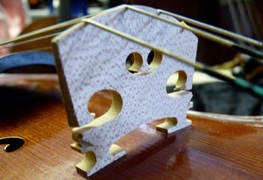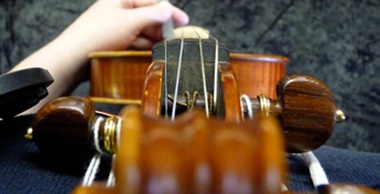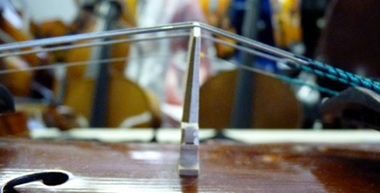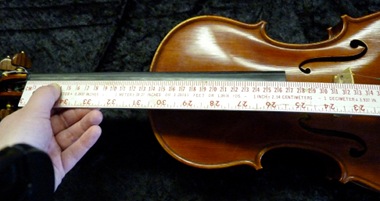Master Hand Violin Shop
Store Hours
Owner
Elizabeth Ecklund
Elizabeth Ecklund
Not so infrequently a customer comes into our shop needing a new bridge for a violin or cello. Upon learning that we charge $50 to fit a bridge to a violin and $80 to a cello, the customer's jaw often hits the ground. Much like pharmacists are assumed to do nothing more than throw pills in a vial, people assume we just slap a bridge on a violin and call it a day. So while our customer is busy recovering his sensibilities, we explain why fitting a bridge is a tricky business.
When fitting a bridge to any instrument, the first order of business is to choose a bridge blank. A good blank shows longer grain wood on the front (what faces the fingerboard) and shorter grain on the back (what faces the tailpiece).


Once the bridge has been selected and oriented, the feet should be sanded so that they fit perfectly to the arch of the top of the violin.


One point to note is that string instruments expand and contract slightly with temperature and humidity. Thus, bridge height can fluctuate throughout the year. Usually this is not a problem, but some players do need different bridges for summer and winter.
Once the bridge is the correct height on the violin, it needs to be properly shaped. The front side needs to be thinned by sanding at an angle while the back should remain perpendicular with the body of the violin.


When the bridge is finished, the violin should be strung up and the bridge placed such that the string length (distance from the nut to the bridge) on a standard 14" violin is between 328 and 330mm.

(*If you are trying this at home, never ever string up your violin without the soundpost in place!*)
Upon further reflection, if I went to Master Hand looking for a new bridge for my violin or cello, my jaw would probably hit the floor too... because I couldn't believe the bridge didn't cost more!
Share on Facebook